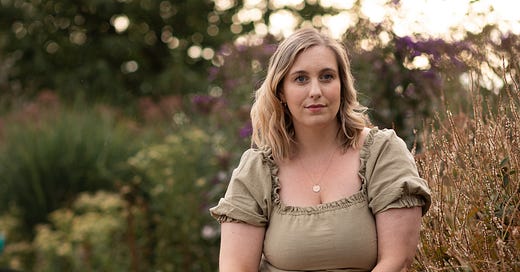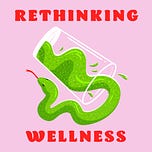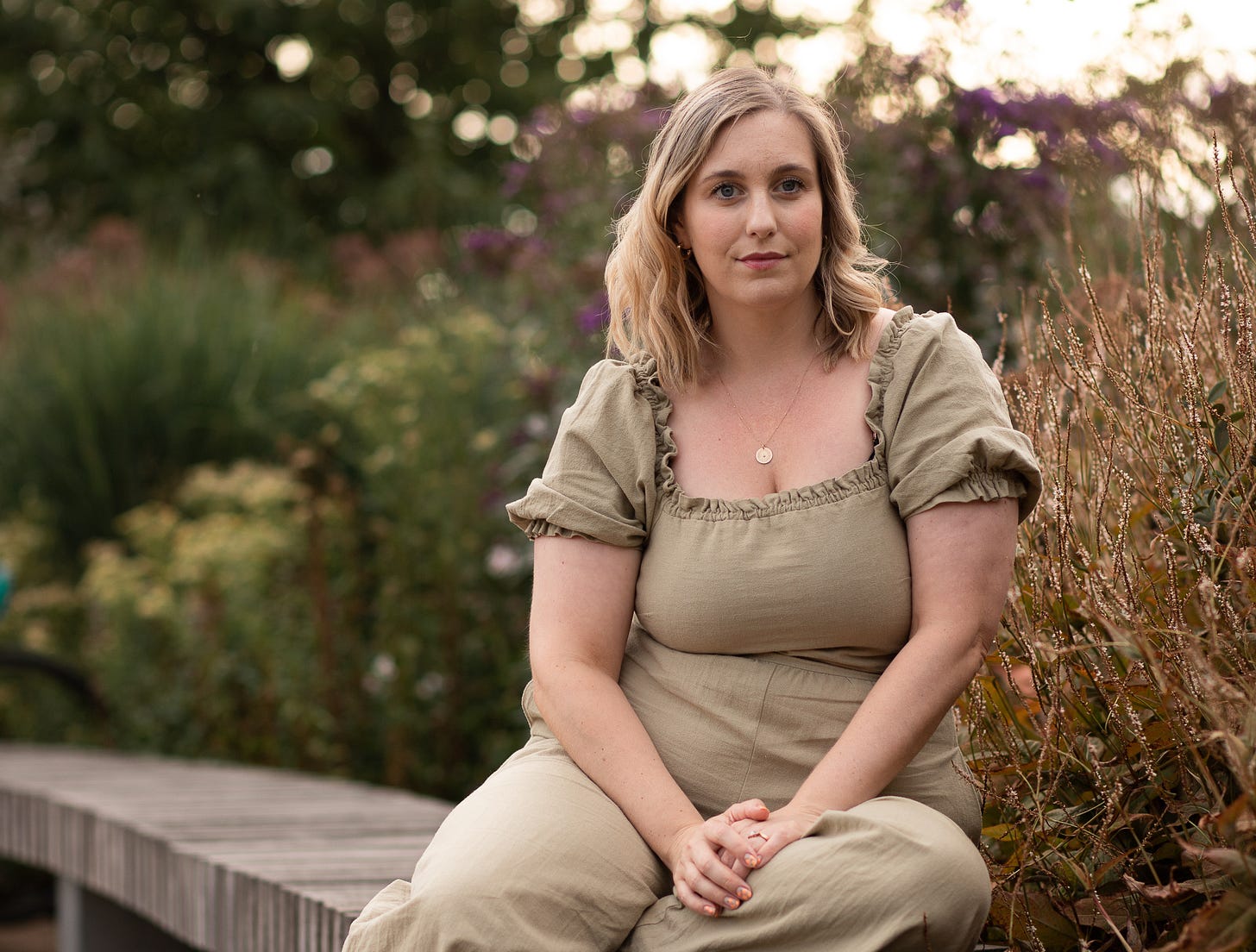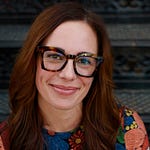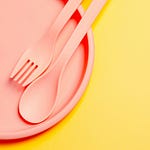Nutritionist and author Laura Thomas joins us to discuss what it’s like for kids living in the long shadow of clean eating, the “almond mom” trend on TikTok, the "wellness to woo pipeline," how parents and caregivers can let go of wellness-culture beliefs about food for themselves and their kids, and more.
Laura Thomas is an anti-diet Registered Nutritionist. Her clinical work focuses on supporting parents and families to end intergenerational dieting and body shame, and work towards a greater sense of embodiment and ease in their relationship with food. She supports families of children experiencing a wide range of feeding and eating challenges, such as concerns with weight, very selective eating, food preoccupation, and other feeding and eating differences. Laura also runs the newsletter, podcast, and community Can I Have Another Snack? on Substack, where she is exploring bodies, appetite, and identity with a focus on parenting. She is the author of two books: Just Eat It and How To Just Eat It.
Resources and References
Christy’s upcoming book, The Wellness Trap: Break Free from Diet Culture, Disinformation, and Dubious Diagnoses and Find Your True Well-Being
Laura’s Substack, Can I Have Another Snack?
Laura’s books, Just Eat It and How To Just Eat It
Laura’s piece “The Kids Standing in Clean Eating’s Long Shadow”
Katja Rowell’s book Helping Your Child with Extreme Picky Eating
Katja Rowell’s book Love Me, Feed Me
Christy’s online course, Intuitive Eating Fundamentals
Transcript
Disclaimer: While every effort has been made to provide a faithful rendering of this episode, some transcription errors may have occurred. The original audio file is available here.
Christy Harrison: Welcome to Rethinking Wellness, a podcast exploring the diet culture, disinformation, dubious diagnoses, and disordered eating that are so pervasive in contemporary wellness culture--and how to avoid falling into these traps so that you can find your own true well-being.
I’m your host Christy Harrison and I’m a registered dietitian, certified intuitive eating counselor, journalist and author of the books Anti-Diet, which is available now, and The Wellness Trap, which comes out on April 25th. You can learn more and pre-order the book at christyharrison.com/thewellnesstrap. That’s christyharrison.com/thewellnesstrap.
Hey there. Welcome back to Rethinking Wellness. I'm Christy, and my guest today is Laura Thomas, an Anti-Diet registered nutritionist and author of the books, Just Eat It and How to Just Eat It. We talked about so much in this conversation, including how wellness influencers often shame parents into feeding their kids in restrictive ways, what it's like for kids living in the long shadow of clean eating, the almond mom trend on TikTok, how parents and caregivers can let go of wellness culture beliefs about food for themselves and their kids, and lots more. I love this conversation and I can't wait to share it with you in just a moment. Before I do a few quick announcements.
If you like this show and want to help support it, I'd be so grateful if you'd subscribe, rate and review. You can do that wherever you're listening to this. And you can also get it as a newsletter in your email inbox every other week where you can either listen to the audio or read a full transcript or both. Subscribe to that at rethinkingwellness.substack.com. That's rethinkingwellness.substack.com.
This podcast is brought to you by my upcoming book, The Wellness Trap Break Free from Diet Culture Disinformation and Dubious Diagnoses, and find your true wellbeing, which is available for pre-order. Now. The book explores the connections between diet-culture, and wellness culture, how the wellness space became overrun with scams, misinformation and conspiracy theories, why many popular alternative medicine diagnoses are misleading and harmful, and what we can do instead, to create a society that promotes true wellbeing, just go to christyharrison.com/thewellnesstrap to learn more and pre-order the book for its April 25th release. That's christyharrison.com/thewellnesstrap, and once pre-ordered, you can get a special bonus Q & A about the book with me by uploading your proof of purchase at christyharrison.com/bookbonus.
Now, without any further ado, let's go to my conversation with Laura Thomas.
So Laura, welcome to the show. I'm so excited to talk with you again for this new podcast series, Rethinking Wellness.
Laura Thomas: Oh, thank you for having me. I'm so excited about the book and the new podcast and yeah, just your wellness era.
Christy Harrison: Yes, this new phase, new chapter. Well, for both of us, it was an old chapter too, right? Cause we had our own experiences in wellness culture, and I would love to start off by talking a bit about your experiences with wellness culture. Cause I think some of the folks listening won’t have heard your episode on Food Psych, and also it was many years ago now that you shared about your history with wellness and food. So love to have a brief recap of how you first got into wellness culture and what that was like for you and what it brought up.
Laura Thomas: Yeah, it’s been interesting to kind of think about this in the past couple of days knowing that we were going to be having this conversation, and I think I probably uncovered some things that I didn’t even touch on in the last episode that were kind of buried down deep in the recess of my mind somewhere because I just don’t want to have to deal with it. But I had been vegetarian since I was about 10 or 11 years old. That was something that was really important to me as a kid, and as I got older, that developed into veganism. And for me that was coming from a place of care and welfare for animals as well as the environmental sort of aspect of things. And I am by no means a militant vegan who thinks that I need to convert everyone to veganism. But it is important to me personally. And I think the, the bridge from veganism to wellness and ultimately into woo kind of culture is a real slippery slope. What started off as a, I don’t really love this word, but as an ethical choice, as you’re learning more about veganism and how to navigate the world as a vegan, you inevitably bump up against diet and wellness culture and some alternative medicine stuff. And what I was thinking about earlier today is how in my maybe early to mid-twenties, I started developing a lot of joint pain in my hip and my hips. And at that time I was always looking for new recipes and ideas for how to feed myself as vegan and coming up against a lot of blogs in the wellness space that were vegan, but also gluten-free and oil-free and this free and that free and free of all of the things. And somewhere along the lines, I think I picked up the subtext that things like gluten and oils were probably contributing to inflammation and pain and so on. And there were points along the way where my diet was just so restrictive because I had internalized these ideas. And the most concerning thing I think is that I was getting a PhD in nutrition and was so simultaneously kind of soaking this stuff up on the one hand and then being really critical of the research and the science on the other hand. And so it’s just an interesting kind of juxtaposition, I think. But ultimately, I think that grounding and that training in science and having that critical perspective was what helped me snap out of it as well as coming across in cheese Feeding and health, every size and these other models that we’ve spoken a lot about on Food Psych.
Christy Harrison: Yeah. Well, I’m so curious with the decision to become a nutritionist in the first place, how did your own history with wellness culture kind of play into that?
Laura Thomas: That’s interesting as well. I can’t remember if we spoke about this before or not, but I originally started studying a biotechnology at university. So that was my major in undergrad. I can’t even really tell you what that is, to be honest, Christy. But probably somewhere in my first year, there were a lot of different popular nutrition shows on TV here in the UK. And I remember one in particular called “You Are What You Eat”. I don’t know if you’ve come across this with any of your other guests or in your research, but oh my God, it’s heinous to think to look back at it now. But the premise is this nutritionist, and she’s not a real nutritionist, but she calls herself Dr. Gillian McKeith, and she has some bullshit degree from some made up university or some integrative medicine type place. And I don’t know exactly what the degree is, but it’s not legit. So she had this show on mainstream TV here where she would go into the homes of people who she considered were eating these really trashy diets. Generally speaking, they were fat folks and it was all about, she was the literal food police going in rummaging through their cupboards. She would do this thing where she would lay out all the food that they were eating over the course of a week on one single table and wheel in a wagon full of that plastic rubbery fat models that you use in dietetics programs to show people this is a pound of fat or whatever. She would wheel in a wagon of that or a wagon of lard or something to get the most extreme shock reaction from the audience because it’s a visual medium. So you have to go for all these shock tactics. And of course if you lay out someone’s entire food for a week, It’s going to look like a lot of food because we don’t see that much food all on the table at once. But when you eat three meals and multiple snacks a day over the course of a week, That’s up to a lot of food, but it’s also no shit Sherlock. But the way that it was framed was like, this food is disgusting, it’s poison, it’s going to kill you. And she basically went in and took out everything that they were eating and would replace it with seeds and nuts and alfalfa sprouts and put people on these. What I can see now is extreme diets and they would of course lose a lot of weight because they were probably malnourished. But this show was part of what hooked me into nutrition because it was so captivating and what she was doing I now understand is not real nutrition practice. It’s some, she would look at people’s poo in the toilet. I have three nutrition degrees and I have never looked at anyone’s poo in the toilet before. I’ve looked at poo stool charts, but I’ve, I’ve never examined someone’s fecal material, nor should you, I think, no, don’t, do not recommend. So I think there was something really compelling in that show at the time that made me want to learn more about nutrition. And I did. I picked up some legitimate textbooks and started reading them, and then I switched my major to nutrition. So it was with the kind of background of this sort of pseudo nutrition or this idea of what a nutritionist was, which actually isn’t grounded in any reality. The anti-fat bias was accurate, but apart from that, we’re not prescribing alfalfa sprouts for folks.
Christy Harrison: That’s so interesting, too, that hooked you into this idea of becoming a nutritionist like that this was a way to help people. Cause I think that for me too, I mean there was never anything quite as overt about painting a nutritionist, although I definitely liked was very influenced by Michael Pollan, Marian Nestle, people who were doing that work on the food systems level. Oh yes,
Laura Thomas: Same.
Christy Harrison: Wanted to model my career on theirs and thought that what they were doing was so amazing. And in some ways, I mean, they’re great writers, they have a lot of things to say and some of their work I think has been valuable. But I think overall, this idea of demonizing processed foods and foods that aren’t hyper local and elevating those kinds of foods to this place of cult status or whatever in society and kind of paving the way for clean eating. The clean eating movement, I think really grew out of Michael Pollen and his ilk sort of philosophy and that that’s really done a lot of harm, I think, in the grand scheme of things.
Laura Thomas: And I definitely got into the Marion Nestle, Michael Pollan sort of Food Inc. stuff a little farther down the line that was more in my Dr. Bronner hair washing stage. I literally walked past a bottle of Dr. Bronner’s the other day and had flashbacks to really matted tangled
hair, and it’s all connected to the same thread, that same philosophy of purity and cleanliness and the E W A whatever, clean personal care and hygiene care and makeup and all of that stuff. I definitely went deep into that for a while using coconut oil as moisturizer or whatever the fuck. Again, I think once you are connecting into some of this stuff, it’s very easy for it to just seep out into, you know, start with food, but then it seeps out into your personal care, the products that you’re using in your home, maybe even the clothes that you’re buying. And then more dangerously obviously getting onto medicine and functional medicine and the rejection of traditional medicine, which I’m not saying is flawless, but is there for a reason.
Christy Harrison: It is a slippery slope. I talk about that in the book too, that it can often start with clean eating or whatever it’s calling itself these days, the sort of whole foods plant-based diet or plant predominant or whatever. It’s a very easy slide I think because of the communities that people often find themselves in when they get into that way of eating. And the social media algorithms like feeding people, more information about clean beauty and clean home and lifestyle, and then it’s a pretty easy slide from there into anti-vaccine rhetoric. And social media algorithms do a lot with that too, at least in past years. And I think they’re trying to change this, but there’s been a lot of recommendations of anti-vaccine groups to people in that sort of crunchy space. And so it becomes really easy, I think, for people to go from this kind of innocent, I want to eat for a better environmental footprint, or I want to eat in a way that’s sustainable, or I want to eat in a way that’s better for my wellbeing or my health, or whatever. Thinking that that’s the thing you need to do is overhaul your entire menu for totally unprocessed or minimally processed foods and then suddenly you’re in this whole, it’s a rabbit hole to this portal to another space where everything, every chemical is potentially deadly. Every household product decision is a life and death one. Every decision about medical care is extremely fraught and can start getting into these alternative spaces and stuff to get away from what you’re perceiving as this chemical laden, big pharma sort of industrial form of medicine, which again, like you said, it’s western medicine. Conventional medicine is not perfect by any means, but I think in a lot of cases, the more alternative spaces or integrative spaces can be even more dangerous because there’s less oversight and regulation and a lot more unproven types of things that are being recommended to people.
Laura Thomas: Yeah, and going back to what I said at the very beginning, the reasons that I got into or when some of these ideas were so convincing and appealing to me is because I was struggling so much with pain and I continue to struggle with pain, and It’s been exacerbated by having a baby and developing pelvic girdle pain, and I’m still looking for answers, and I feel like I’ve been let down by my doctor. I feel like I’ve been let down by the physiotherapist and the conventional people that I’m who I should be or let me try and reframe that a little bit, that the folks that who are sensibly there to help me, I have felt gas lit by them. I have felt like they weren’t taking me seriously. I’ve been dismissed. And so I can see why It’s so appealing to be pulled down into alternative medicines and looking for an answers because I think something that happens in these communities is that you are held and you’re seen, and that doesn’t always happen in traditional medicine. And I think that that’s why they can feel like the right place to be.
Christy Harrison: Yeah, absolutely. I very much identify with that too, as someone with multiple chronic illnesses and having had misdiagnoses and diagnoses for a long time and feeling gaslit by the healthcare system at various points. And it is so appealing to have someone who’s going to spend a lot of time with you and the providers who don’t take insurance probably, but are going to give you an hour long session and really talk to you about what’s going on for you and look at every lab value, scrutinize it and look for things that are like, well, this is subclinical, but this combined with this might mean this. And there’s a lot of hope there. There’s a lot of feeling like, okay, this person’s really taking me seriously. They know what they’re doing. They’re giving me a lot of empathy and support, and they’re finding something that the general healthcare system has missed. And I definitely went into that myself a number of times, and ultimately it was not the right diagnosis or not the right fit in terms of treatment or whatever. But It’s so easy I think, to fall down that path because you’re like, well, at least this person’s listening to me and taking me seriously, and whereas this other doctor’s kind of dismissing me and telling me nothing’s wrong.
Laura Thomas: And I think it’s really frustrating as well when your doctor or your regulated healthcare professional is saying, I’ve exhausted everything that I can think of to offer you and I don’t have anything else to give you. Whereas an alternative medicine person might be like, well, look, we haven’t tried cutting out this thing, or have you tried this supplement? And sometimes those solutions feel, well, first of all, there is a solution and It’s in the grand scheme of things, feels simpler than I’m really sorry. But bodies are really complicated, and we haven’t figured them all out. We haven’t figured everything out about bodies yet and how to make them feel comfortable all of the time. So yeah, that I think is another aspect of this is that these seemingly simple solutions can be really appealing, especially when you’re running out of other options.
Christy Harrison: How did you get from there? You know, mentioned you had a baby and now you do a lot of work around child feeding and helping parents break free from diet and wellness culture. And curious how you got from having your own chronic pain issues and kind of dabbling in that or being in some ways very far into that wellness space to where you are now.
Laura Thomas: Yeah, I mentioned before, I think having an innate skepticism of just about everything sort of helped pull me out of that kind of wellness funk as it were. And I noticed that my own relationship with food was struggling and that I was engaging in a lot of disordered eating and the chronic diet cycle. And then I came to work like yours and health every size before that and some other body liberation work. And it really resonated with me. And so I kind of applied it in my own life. And then when I was working with clients, I was seeing a lot of anxiety about the sort of cleanliness of their diet or the purity of their diet or trying to micromanage everything so that it was the right way of eating or trying to perfect eating and seeing the consequences for their mental health as well as their physical health because we know that anxiety is stored in the body and shows up in the body, it affects your digestion and sleep and so many aspects of your health. And that’s when I realized it was what I was seeing. It wasn’t about the food; it was about people’s relationship with food. So I did more research and learning and professional supervision and professional development around Intuitive Eating and Health At Every Size and helping support people have a healthier relationship with food. And that really kind of transformed my practice. And then the piece around kids I think is really interesting because I think everyone sort of assumes like, oh look, she had a kid and now she won’t shut up about kids. But this work goes back a lot further than me having a baby. And the genesis of my interest in feeding dynamics and the relationship that that kids have with food and how we can support them to have a positive relationship with food really originated in my clinical work with adults. And hearing this not the same story, obviously everyone has their own unique stories, but hearing really similar stories from my clients about the genesis of their disorder, eating the genesis of their body shame in childhood, and also working with parents who didn’t want to pass those same struggles onto their children, really wanted to do something to protect their kids’ relationship to food, to help keep them positively embodied. And That’s when I started thinking a lot more about this stuff and doing training in Ellen Sattar’s work and learning a lot more from our colleagues in peds who were doing Anti-Diet work with kids. And I guess it was 2018, along with my colleague Jess Ran, who’s a dietician, we developed a Raising Intuitive Eaters course. So this goes way back. I’ve been doing this work kind of lowkey for a long time, but I think being a parent, it’s not that the messages that I’m sharing with my clients and the people that I work with has really changed all that much, but definitely the way that I’m talking about these things has changed from the perspective that I know just how much pressure there is on parents, and I feel that pressure a lot myself. And so trying to really think about how can I frame this in a way that helps take the pressure off of you to feed your child perfectly and also takes the pressure off of them to be this perfect ear of which we know that that doesn’t exist. The perfect diet doesn’t exist, but what can make a big difference is the relationship that you have with your child around eating and also how you are modeling, talking about food, talking about bodies, and treating your own body. So that’s kind of where my work lies now, but It’s always been there. It’s not like this new thing that, yeah, I’m not that trope.
Christy Harrison: I think it makes so much sense that you would go into this space and that I think people’s relationships with food start so early. And so being able to help someone develop a peaceful relationship with food from the get-go to the extent that’s possible in diet and wellness culture with all the pressures they put on us is so important. And you’ve written really beautifully, and as we’re talking, you just came out with a newsletter about cool moms and yummy mummies on social media and how these influencers really create pressure on parents and shame them in a lot of ways inadvertently, but make people feel shamed into feeding their kids in restrictive ways and the idealized images of the bento box with all the vegetables and fruits or the plate that looks like an adult version of what we think of as healthy eating and how these idealized images actually cause parents in some cases to feed their kids in restrictive ways or ways that are not appropriate for them developmentally. So I’d love to talk a little bit about that, about the pressures that you’re seeing on social media, in particular on parents to feed a certain way and the unintended consequences that can have.
Laura Thomas: Yeah, it’s messy and it’s complicated. And I think the thing that feels really important to say upfront is that no parent is trying to intentionally feed their kid in a way that is harmful or that doesn’t meet their requirements or their needs developmentally or nutritionally. But unfortunately, there is a lot of shitty advice on social media and there is a lot of unrealistic pressures and expectations. And what I think feels so slippery about this is that sometimes we’re getting bad advice from credentialed professionals, not just the kind of crunchy mum influencers. There are a lot of folks that are registered professionals who are contributing to the pressure of Feeding your kid. And There’s a book that came out here when the subtitle was like, how to Make Your Kid Love Broccoli as much as they love Cake. And that’s the expectation that parents have is that if I follow all the rules, if I follow all the advice and the things that I’m supposed to do, if I do it all right, all the way from breastfeeding to baby led weaning, to introducing two weeks of green foods, first to whatever we’re told to do when they’re toddlers all the way through to older kids and adolescents, if we do everything, then we will manufacture these perfect eaters and then it’s all very well to read what you should do on social media. But when you’re faced with a reality of a child who maybe has sensory processing differences, maybe is divergent, has additional needs, or is just going through what I like to call typical toddler food fuckery where they developmentally they start rejecting mixed foods and bitter foods because that would have conferred an evolutionary advantage because typically those foods were associated with maybe poisonous or toxic, if we’re talking about cave people days, that would be a totally developmentally appropriate stage for most kids to go through. And yet we are told that they should prefer broccoli over cake. So you can see how we get this disconnect between the reality of how our child is eating versus how we’re told that they should eat. And in that kind of gap, we see a lot of fear, we see a lot of anxiety, we see a lot of worry, which is completely natural because feeding our children and feeding them well and helping support their nutritional needs is something so fundamental to being a parent. You and I have spoken on my podcast about what it feels like when you can’t feed your child in the way that you want to or expect that you should be able to do, and it’s a fundamental role of being a parent, is to nourish your child. And so when they start throwing things all over the floor and it seems like they’re not eating, it stirs up something very primitive in us. Yet what we’re seeing on social media is like, oh, well, if you just cut your mortar melon into the shape of a star, then they’re going to start eating it When these strategies that were presented with because they’re grounded in, well, they’re not grounded in the reality of child psychology or typical developmental stages, it leads to more worry and pressure and anxiety. And then we start to feed from a place of control and restriction, coercion, bribery, just take another bite, or you have to eat three peas before you get down from the table, or we’re trying to constantly override their eating instincts for how much they need. Then we get ourselves into a really murky place with the Feeding relationship. So I think I’ve kind of monologue at you for a minute there. So wondering, did I even answer your question? What bits have I have I not touched on?
Christy Harrison: Yeah, no, that is also fascinating and important and I think really is helpful for parents to hear about the developmental appropriateness of neophobia or craving certain foods more than others and not liking things like broccoli as much as they sweet carby things like cake in your newsletter about this. We’ll link to that in the show notes too. But you talk about specifically the proportions of carbs and fat that kids need, that little kids need is way higher than what we’re sold in diet and wellness culture as being healthy. And that the so-called healthy plate for kids and toddlers really neglects those needs and that it’s going to look completely different than this thing that’s mostly vegetables and fruit or whatever, and protein too, that there’s higher amounts of protein and lower amounts of carbs and fat recommended to little kids than they actually need.
Laura Thomas: Yeah, we see a lot of the patterns that we see in diet and wellness culture, sort of like this protein supremacy and car phobia, it translates into feeding our kids as well. And so we end up seeing these plates that resemble what we think is good for adults, which arguably isn’t always the case, but yeah, sort of being super imposed onto kids, it actually causing them a lot of problems. So what I see and hear a lot of is toddlers who are being fed similar diets to their parents, where again, there’s a sort of emphasis on whole grains and high fiber diets, and then these kids ending up having high levels of toddler diarrhea, which is quite common in toddlers. But when we look at the diet, we notice how actually these diets that resemble adult diets may actually be contributing to the problems that these kids are experiencing. Now, something like toddler diarrhea is not that big a deal as long as the kid is well hydrated, growing all the usual caveats that we would want to make sure that they were doing well, but generally speaking, that’s not going to cause much harm. What I talk about in the essay and what we see in the literature, and anecdotally my colleagues have seen as well, is when the principles of clean eating get taken to really extreme lengths and it is extremely harmful. So there was a case study that I wrote about in that piece on clean eating where a family wanted to, again, they were well-intentioned, but we need to pass the intention to the harm that was caused. This family put their four month old baby on a homemade formula made of hemp seed and sea moss and some other kind of whole foods type ingredients where there was no supplementation of vitamins or minerals, and the baby at six months old was admitted to hospital with hypocalcemia. So dangerously low blood calcium levels and rickets, which is a disease that we see, we don’t see, I should say it’s a disease that apart from in severely malnourished children typically as a result of poverty, but these are affluent families who are putting their children on these unnecessarily restrictive diets and it’s causing a lot of harm. And I believe that you can trace this really harmful treatment of children. You can trace it back to mainstream wellness influencers who on the face of things, people think are quite reasonable and have a good message about eating more vegetables or eating more whole foods. But the problem is, as you’ve talked about in your book, is how quickly that can morph into something much more extreme and much more dangerous.
Christy Harrison: Well, that’s right, because it’s such a slippery slope and it becomes, if you take it to its logical conclusion, somebody feeding their four-month-old this homemade concoction because with all the best intentions, they think that that’s better for their kid than formula and have been told these lies in wellness culture about how formula is full of chemicals and toxic and whatever
Laura Thomas: Ultra processed food, yeah.
Christy Harrison: And that to make your kid healthy and give them the best possible start in life, you need to be doing this wellness stuff. And it’s completely understandable and heartbreaking that parents would think that that’s what they need to do, and just ends up with this unintentional harm being done to the kid that the parent was trying to avoid, that kind of thing in the first place. They’re trying to give the kid a good start in terms of their wellbeing and unintentionally just undermining it. And yeah, I think it’s really going back to social media. This is my bug bear these days because I’ve started to see how powerful these algorithms are in driving people from something that might seem on the surface to be pretty reasonable and balanced or whatever to these more extreme kinds of cases. But even with the stuff that
seems reasonable and balanced on the surface, the popular baby-led weening accounts, for example, it seems like this is great and this is teaching them like a balance and it’s not totally excluding fun foods or whatever. And in fact, often does lead to this incredible anxiety and feeling like I need to be feeding my kid in this certain way, and that there’s demonization of sugar and processed foods is kind of implicit in a lot of it because, and carbs, we’re not really seeing those foods and carbs, we’re not really seeing those foods in the beautiful photos on Instagram or whatever. In part because I think showing a lot of carbs, which is the bulk of a young child’s diet most of the time isn’t as legible or as beautiful on Instagram. If there’s something about it that the medium has created the message or influenced the message where it’s like, okay, how can we be eye-catching and grab people? And I wrote a little bit about this in my newsletter about baby-led weening has these images of a very young baby chewing on a whole turkey leg or chicken leg or something or holding these giant pieces of food that they’re gumming on. And it’s shocking and it’s kind of upsetting to a lot of people, I think, to see that and to it sort of creates this perfect storm that drives people on social media to spend more time looking and spend more time engaging with that content. And I think that that’s a big piece of it too, is these images are sort of arresting, whether it’s because it’s beautiful food that you think you should be getting your kids eat, or It’s because it’s something that you would never expect a baby to be able to eat without choking, and yet you’re being told that this is good, and oh, gagging is not the same as choking. And it’s okay if they have violent retching when they’re trying to eat this food. And I think it really makes parents second guess themselves about what feels right to be feeding their child. And for me too, to see as a fairly new parent, to see these things and feel targeted by them has been really interesting. And for myself, I have to tease apart, okay, what of this is coming from this toxic wellness and diet-culture that is something I don’t want to participate in? And what of it, if anything, is useful that I could potentially take for my feeding relationship with my baby?
Laura Thomas: You’ve touched on something there that I think is really important, which is the conflation of aesthetics with good advice about feeding, feeding our kids or you know, can trace it back, I think to wellness culture, toxic wellness culture more broadly. And I’m thinking about this account called really very crunchy. I don’t know if you’ve come across it, but it’s kind of blown up in the past sort of year or so. And initially I was like, oh, this is funny. This is someone who is parodying crunchy mom culture. She plays the part really well and she has the aesthetic down, but it’s funny she’s taking the piss out of herself, but holy shit, if you go into the comments, those people are serious about crunchy stuff. But some of the more extreme views on diet, and if they do a parody about, I don’t know, diet Coke, people will get in there with a conspiracy theories about Diet Coke and artificial sweeteners. And it’s difficult, I think when you go to something like that thinking, okay, this is a parody, this is comedy. But then you end up getting sucked into the comments and it plants that seed of doubt. And I often hear from parents as well that they start following people, I don’t know, these homesteaders and these crunchy moms because they really want to find out about, I don’t know, raising chickens, but the food stuff infiltrates. And literally the other day, one of my good friends sent me this post from, again, a crunchy mom. She’d followed her because of the aesthetics and some of the values that she was talking about aligned with my friends. But then she started talking about the dies in Cheers and how they affect her kids’ behavior and stuff. So it’s really easy to see how we get hooked into something because it feels like this is aspirational, I like this aesthetic, this is something I want to learn more about. I don’t know, homesteading. Then it quickly morphs into something else that’s a lot more dangerous. There’s nothing wrong with giving your kid Cheerios, it’s fine. I give my kid Cheerio Cheerios, I’m not worried about it. It just ends up morphing into this nutritional extremism that is really scary.
Christy Harrison: So we’ve been talking a lot about the anxiety parents feel in response to all this pressure from wellness culture and diet-culture. Love to talk about antidotes to that or ways of being resilient to that or navigating that. So how do you think parents and caregivers can start to let go of this wellness culture, pressure wellness culture, beliefs about food and resist the pressure to feed kids “perfectly”?
Laura Thomas: Yeah, there are a few different ways we can think about this. And I think something that I really took from your book, Christy, and that I think something that I’ve known intuitively, but just to read it on those pages really crystallized to me how toxic social media can be, particularly in the way that the algorithm has this way of being able to tap into those anxieties and reflect more of that back to us. So for example, if we are hovering over a perfectly curated lunchbox, even though we’re not liking it, if we are in an anxious state where we’re kind of scrutinizing it and thinking about, oh, well I don’t have that in my lunchbox, or I don’t have that and in my kid’s lunchbox, then the algorithm doesn’t know that we’re having a negative emotion as we are viewing that content. All it sees is, or all it can perceive is that we’re hovering over it, therefore it thinks we want more of it. It will keep feeding us the perfectly curated lunch boxes or the foodie dietician lady that serves these perfect meals to her kids, but also is giving you kind of fearmongering information that if you don’t feed your kids, if you don’t wean your babies with broccoli, that they’re going to develop this sweet tooth and they’re just going to be this insatiable sugar monsters or whatever it might be. So I think the message there is to be really cautious of what you’re engaging with on social media. Find a couple of people that you trust that are sharing information from a non-diet and responsive feeding lens, and if you need more support than that, maybe finding some books or again, written by people who are credible and are sharing evidence-based information, but in a non-fearmongering, non-scary, anxiety-provoking way. So I can give some resources that are helpful. Katja Rowell’s book on extreme picky eating is a great place to start for so-called fussy eating, and she co-authored that with Jenny McGlothlin. And then another book that I really love is her older book, but she’s just re-released it, which is called Love Me Feed Me. And that’s a book that is primarily aimed at adoptive and fostering parents, but I think has a lot of really great information about food preoccupation, responsive feeding. It’s just a really great resource that parents can dip in and out of for kids across the sort of age spectrum. So it’s not specifically for weaning, for example. So yeah, there are some helpful resources that we can take things offline and I think that that would serve us really well, particularly because there are real genuine problems that we experience with feeding our kids that we might need some support around, or it’s obviously not available and accessible to everyone, which is a whole issue in and of itself. But working with a responsive feeding professional, again, someone who is aligned with an Anti-Diet approach, ideally a health, every size or weight inclusive approach as well. So yeah, that’s the first sort of layer. But I think the most important thing that we can do to support our kids to have a healthy relationship with food is take a look at our own relationship with food and wellness culture and diet-culture, really interrogate that. And if we’re noticing a lot of fear, worry, anxiety about what our kids are eating, for me that’s often a red flag that we need to look a little more closely at our own relationship with food and maybe do some work around Intuitive Eating looking at where diet-culture and wellness culture showing up in our lives and ask, how is this serving me? In what ways is this serving me? Why am I doing this to myself? Why am I feeding my brain with more and more diet-culture and wellness culture related content or ideas? And how can I take a step back? Because I also understand that as a parent, we’re looking for control, we’re looking for certainty, we’re looking for, we all want to do the absolute best for our kids, but sometimes it comes across not just in terms of our kids’ relationship with food and their bodies, but also in our relationship with our kids. And I think we can see that so clearly in the almond mom trend on TikTok where, and I think it’s actually really cool that Gen-Z and maybe younger millennials are calling out their parents’ weird diet-culture bullshit on TikTok. It’s like a positive use of social media. I think some of it’s really, really upsetting in that there are people who have gone on to develop really severely disordered eating and eating disorders as a result of, I don’t want to just do parent bashing and parent blaming hair because they’re eating disorders are more complicated than this. But a lot of those TikTok users are attributing their eating disorders and disordered eating to their so-called almond moms.
Christy Harrison: Who feed them these raw almonds as a snack instead of something more interesting. I think that’s where that term comes from.
Laura Thomas: It came from actually Yolanda Hadid, Gigi Hadid’s mom, and they were, it was a whole series of real housewives. I didn’t watch it, but this is what my sleuthing has uncovered. There’s like a whole montage of all of this supremely disordered stuff that Yolanda Hadid has said to Gigi in order to manipulate her eating and her body have all these rules and restrictions on what she can and can’t have, and it sparked this trend on TikTok where, like I said, Gen-Z and maybe younger millennials are calling out their parents’ bullshit and being like, no, this is not okay. This is toxic diet-culture. This is wellness culture. This is the collateral damage from these really messed up beliefs around food. So I think in some ways it’s great that these, I’m saying kids, but you know what I mean, are kind of pushing back on the almond mom narrative, but it also raises the question of how much damage was done before it got to a point where they were able to recognize this and it becomes sort of a phenomenon. So I don’t know how we got into that little rabbit hole. Maybe you can reign me back in a little bit.
Christy Harrison: Yeah, well, I think mean, it’s interesting actually, that is being, that’s becoming a trend and I think parents are becoming aware of that and maybe it’s helping people reflect a little more on how they relate to kids around food and body stuff. But it also does have such a shaming element too. I think it’s so tough to see your own, how your own maybe disordered relationship with food and your body and your own buy-in to really harmful wellness culture beliefs has trickled down to your kids and influenced them. And I see so many parents who feel really guilty about that and want so badly and work so hard to try to not impart that stuff to their kids. And yet sometimes it just sort of leaks through. It can’t help but influence kids I think sometimes because of the culture we live in and because it’s really, really hard to recover.
And I think too, there’s so much pressure on parents to feed a certain way that it feels like a really big deal to walk away from diet and wellness culture and do something different. And it feels really scary. It feels like you might be leading your kid astray or something. So I think There’s that real anxiety to reckon with too. It’s not just how do we overcome the anxiety and feed in a more relaxed way, in a more responsive way. It’s also how do we combat the inner critic voices that come up and say, you’re going to harm your kid by doing it wrong.
Laura Thomas: And I don’t know that it’s even just our own inner critic, but it’s also, this is at the heart of mommy wars as well. There’s the fear of judgment from other parents and that sort of sense that your parenting is being scrutinized by everyone, which it is in a lot of cases. That’s not something that I think we imagine, but it’s a real thing. We’ve all had unsolicited advice from well-meaning people telling us that we should do something different. It’s battling our own internal dialogues, but it’s also having to navigate everyone else’s judgment and ideas about how we should parent as well. So there’s that kind of one two punch that makes this especially hard. So if you’re unlearning diet-culture for yourself, and then also unlearning it in the context of parenting as well, it’s like we always talk about you’re swimming upstream when you’re unlearning diet-culture, and then when you’re doing it for your kids as well, it’s trying to swim up a freaking waterfall.
Christy Harrison: And then if you’re larger bodied or have other marginalization that make you more subject to scrutiny, it’s even more so I know parents who are larger bodied parents having to navigate the fat stigma that’s coming at them around how they feed their kids in addition to their own internalized diet-culture. And these voices that are so self-critical in addition to the toxic wellness culture telling them that certain foods are terrible and should never pass their doorstep, let alone their kid’s lips. And so it’s just coming from all angles.
Laura Thomas: And that’s something that I don’t exactly have experience of, but I’m straight sized. But since having a kid, my body has changed a lot and my body is now technically the O word. And even just noticing the shift in how I’m perceived in losing that tiny little bit of privilege, I still have a ton of body privilege, but noticing how people kind of react to me saying these things has really underlined what I know already, which is how difficult it is to push back against these cultural norms in a bigger body, let alone layering on more marginalized identities on top of that. So yeah, all of this is just to say that it’s really hard to push back against the social scripts that we’ve been handed.
Christy Harrison: It’s incredibly hard. But I think your idea of doing the best you can to not extra activate yourself, not expose yourself to all of that information, to help yourself have an information ecosystem or environment that is not further exacerbating those issues, I think is one small way that people can help themselves have less anxiety around these issues.
Laura Thomas: And this is really one of the big reasons that I wanted to start my newsletter. “Can I Have Another Snack”, was to help create some community around this for people who are navigating these exact challenges. Whether it’s trying to explain to their family why it’s not okay to talk shit about bodies in front of your kids or why it’s not okay to police their food or why we don’t create hierarchies of bodies or food. And when we’re in community, it doesn’t necessarily make it any easier to stop your mother-in-law from fat shaming, but it does give us a safe place to feel heard and seen and understood in that struggle. And I think that community is so essential to help us navigate these difficult, the difficult experience of healing our own relationship with food as well as kind of creating a more positive relationship with food for our kids moving forward.
Christy Harrison: Yeah, so well said. And I think having that community to help you push back on those messages or just empathize with the fact that those messages suck and that its hard and that this is weight stigma, this is fat shaming, this is food shaming, and that you don’t have to just take it, right. I think having people to reinforce that is hugely helpful.
Laura Thomas: Yeah, I think we need more community, whether it’s online or offline, and if it can be away from social media, I think that’s better. But I think we think of going to social media as our first port of call for community, but I think we need these other parts of the internet, which is why I find Substack to be a really helpful place to start building that community.
Christy Harrison: Yeah, I agree. I think finding alternatives to social media for community is really essential so that we’re not in this community That’s kind of throwing gasoline on the fire of our anxieties, of our panic and outrage and confusion, because that’s what those algorithms do is they find those things that are going to keep us on the platform. Like you said, that doesn’t really matter. And in fact, actually what does keep us on the platform more than anything is anger, outrage, division anxiety, these negative emotions discussed. So finding a place away from all that to find true support and connection with other people is so important, which I think is a great segue into talking about your newsletter and where people can find it and what you offer there.
Laura Thomas: Oh yeah, sure. So the newsletter is called Can I Have Another Snack? There’s a podcast as well by the same name, and it’s at laurathomas.substack.com. And it’s really a place that I wanted to create to explore how we can support our kids to have a positive relationship with food and their bodies, but maybe while also sort of figuring out our own stuff around food and bodies and having a body that’s given birth or that has fed a child and how that kind of relates to our own identities and how we show up in the world and navigate all of the stuff that we’ve been talking about today. So yeah, that’s what I’m hoping to do over there. It’s kind of just six months old at this point, so I’m very much still in the process of figuring out all of the moving parts and what people want to read more about.
Christy Harrison: You’re in the weening stage with it.
Laura Thomas: Oh my God. Little nutrition joke. I love it.
Christy Harrison: I know. Couldn’t resist.
Laura Thomas: But yeah, I really love the sense of community that we’re starting to build over there and being able to hold space for other people and share resources and ideas and just have, get a conversation going some of these things has been really great. And also just connecting with other writers on Substack has been really lovely as well. So it feels much more like a community than I think other platforms. So that’s what I’m doing over there.
Christy Harrison: That’s fantastic. Well, we will link to your Substack in the show notes for this episode. And by the time this is out and people are hearing it, this will also be on Substack, so I will connect with you there as well. And yeah, thank you so much for this conversation. This has been so great. It’s lovely to talk with you as always.
Laura Thomas: Oh, thank you so much for having me, Christy. And I just, I’m so excited about your book, and I think it’s such an essential contribution. And I think there was this a sense that sort of wellness culture had gone underground, but it really feels like it’s emerging in all of these really toxic ways. So I’m super grateful for your writing, and yeah, it’s been really illuminating for me, even though I’m all steeped in this stuff. It was really great to sort of be reminded of some of this stuff and also reading it kind of going to a deeper level as well. So thank you for, yeah, really excited about your book.
Christy Harrison: Thank you so much, I really appreciate that.
So that’s our show! Thanks so much to our guest for being here, and thanks to you for listening.
If you enjoyed this conversation, I’d be so grateful if you’d take a moment to subscribe, rate, and review the podcast wherever you’re listening to this. And you can get new episodes delivered by email every other week by signing up at rethinkingwellness.substack.com, where you can also become a paid subscriber for early access to episodes and to help support the show. That’s rethinkingwellness.substack.com.
If you’re looking for help healing your own relationship with food and breaking free from diet and wellness culture, I’d love for you to check out my online course, Intuitive Eating Fundamentals. You can learn more and sign up at christyharrison.com/course. That’s christyharrison.com/course.
If you have any questions for me about wellness and diet culture, you can send them in at christyharrison.com/questions for a chance to have them answered in my newsletter, or possibly even on this podcast sometime in the future.
Rethinking Wellness is executive produced and hosted by me, Christy Harrison. Mike Lalonde is our audio editor and sound engineer. Administrative support from Julianne Wotasik and her team at A-Team virtual. Album art by Tara Jacoby and theme song written and performed by Carolyn Pennypacker Riggs.
Thanks again for listening!

